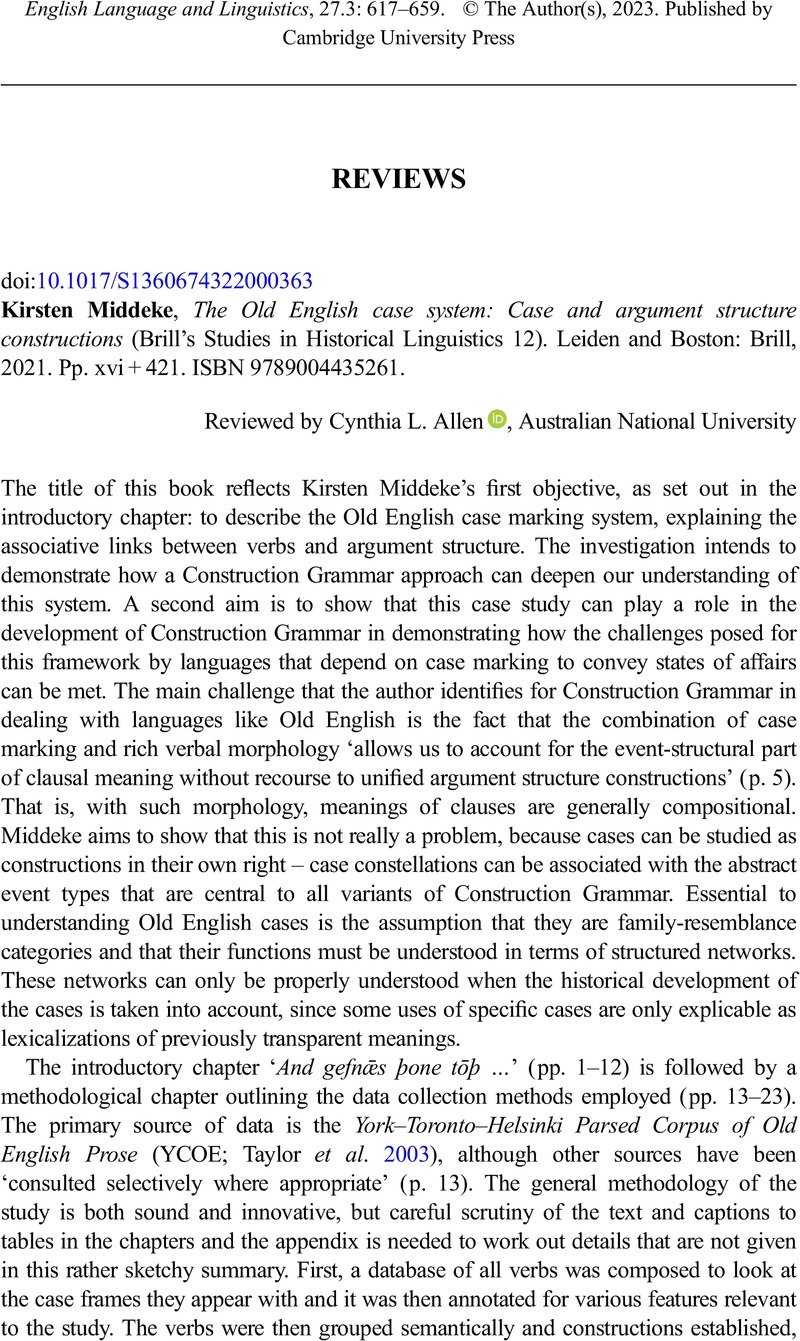No CrossRef data available.
Article contents
Kirsten Middeke, The Old English case system: Case and argument structure constructions (Brill's Studies in Historical Linguistics 12). Leiden and Boston: Brill, 2021. Pp. xvi + 421. ISBN 9789004435261.
Review products
Kirsten Middeke, The Old English case system: Case and argument structure constructions (Brill's Studies in Historical Linguistics 12). Leiden and Boston: Brill, 2021. Pp. xvi + 421. ISBN 9789004435261.
Published online by Cambridge University Press: 16 January 2023
Abstract
An abstract is not available for this content so a preview has been provided. Please use the Get access link above for information on how to access this content.

- Type
- Book Review
- Information
- English Language & Linguistics , Volume 27 , Special Issue 3: Speech representation in Late Modern English text types , September 2023 , pp. 617 - 624
- Copyright
- Copyright © The Author(s), 2023. Published by Cambridge University Press
References
Allen, Cynthia L. 1995. Case marking and reanalysis: Grammatical relations from Old to Early Modern English. Oxford: Oxford University Press.Google Scholar
Bosworth, Joseph & Toller, T. Northcote. 1898. An Anglo-Saxon dictionary, based on the manuscript collections of the late Joseph Bosworth. Oxford: Clarendon Press.Google Scholar
Bosworth–Toller's Anglo-Saxon Dictionary online. Ed. Toller, T. Northcote, Sean, Christ & Tichy, Ondřej. Prague: Faculty of Arts, Charles University. https://bosworthtoller.com/Google Scholar
Dictionary of Old English: A to I online. Ed. Cameron, Angus, Amos, Ashley Crandell, Healey, Antonette diPaolo et al. Toronto: Dictionary of Old English Project.CrossRefGoogle Scholar
Godden, Malcolm & Irvine, Susan. 2020. The Old English Boethius: An edition of the Old English versions of Boethius's De consolatione philosophiae. Oxford: Oxford University Press.Google Scholar
Goldberg, Adele E. 1995. Constructions: A Construction Grammar approach to argument structure. Chicago: University of Chicago Press.Google Scholar
Sedgefield, Walter J. 1900. King Alfred's version of the Consolations of Boethius. Oxford: Clarendon Press.Google Scholar
Sedgefield, Walter J. 1968 [1899]. King Alfred's Old English version of Boethius De consolatione philosophiae. Darmstadt: Wissenschaftliche Buchgesellschaft.Google Scholar
Skeat, Walter W. 1881–1900. Ælfric's Lives of saints (Early English Text Society 76). London: Trübner.Google Scholar
Taylor, Ann, Warner, Anthony, Pintzuk, Susan & Beths, Frank. 2003. The York–Toronto–Helsinki Parsed Corpus of Old English Prose. Department of Language and Linguistic Science, University of York. Distributed by the Oxford Text Archive.Google Scholar
Toller, T. Northcote. 1921. An Anglo-Saxon dictionary supplement. Oxford: Clarendon Press.Google Scholar



